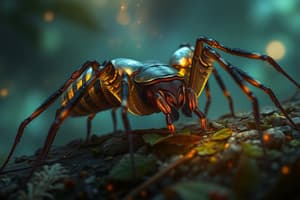Podcast
Questions and Answers
Spiders have ______ pairs of walking legs.
Spiders have ______ pairs of walking legs.
four
Spiders breathe through gill-like structures known as ______ lungs.
Spiders breathe through gill-like structures known as ______ lungs.
book
Spiders have ______ body segments; insects have three.
Spiders have ______ body segments; insects have three.
two
Spiders are so different from insects that they belong to an entirely separate classification of animals called the ______.
Spiders are so different from insects that they belong to an entirely separate classification of animals called the ______.
Spiders see with ______ simple eyes, and they hear and taste with their feet.
Spiders see with ______ simple eyes, and they hear and taste with their feet.
There may be as many as three thousand ______ on the body and legs of a spider.
There may be as many as three thousand ______ on the body and legs of a spider.
The ______ in these digestive juices are so strong that they soften much of a spider's meal to the point that it can be sucked into the spider's mouth with little effort.
The ______ in these digestive juices are so strong that they soften much of a spider's meal to the point that it can be sucked into the spider's mouth with little effort.
Garden spiders lay their eggs in the ______.
Garden spiders lay their eggs in the ______.
A spiderling emerges by breaking through the ______ with an egg tooth.
A spiderling emerges by breaking through the ______ with an egg tooth.
Some spiderlings have been found to land on ships as far as ______ miles out to sea.
Some spiderlings have been found to land on ships as far as ______ miles out to sea.
Flashcards are hidden until you start studying
Study Notes
Spiders vs. Insects
- Spiders have four pairs of walking legs, while insects have three pairs.
- Spiders have two body segments, whereas insects have three.
- Spiders breathe through gill-like structures called book lungs, whereas insects breathe through holes in their bodies.
- Spiders have simple eyes, while insects have both simple and compound eyes.
- Spiders lack antennae, whereas insects have a variety of antennae.
- Most spiders have poisonous fangs that quickly paralyze their prey, a trait shared by only a few insects.
Spider Characteristics
- Spiders breathe through book lungs, which resemble the pages of a book.
- Each "page" (lamella) is separated from the next by pillar-like columns, creating a space for air to flow.
- Blood circulates through the pages, absorbing oxygen from the air flowing between the pages.
Spider Legs
- Spiders do not repair broken legs; they replace them.
- A new leg grows, often shorter than the original, during the next molting process.
- Only immature spiders can grow new legs.
- Mature spiders that lose a leg remain handicapped.
Spider Senses
- Spiders have eight simple eyes.
- They hear and taste with their feet, which have "listening slits" with extremely sensitive nerves.
- These nerves respond to vibrations, triggering immediate responses.
Spider Hunting and Eating
- Spiders use tiny hairs on their legs to examine prey and determine edibility.
- They cover edible prey with digestive juices before chewing, softening the meal.
- The enzymes in these juices are strong, allowing the spider to suck in the softened meal.
Spider Reproduction
- Garden spiders lay eggs in the fall, wrapping 300-800 eggs in an oval, silken cocoon.
- The eggs hatch the following June, with the spiderling emerging by breaking through the egg sac with an egg tooth.
- The spiderling absorbs the remaining yolk into its own body for nutrition.
Studying That Suits You
Use AI to generate personalized quizzes and flashcards to suit your learning preferences.




